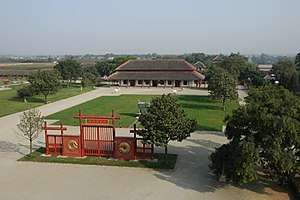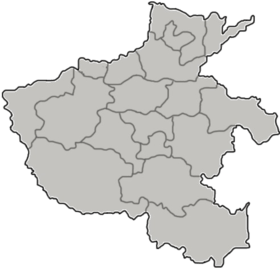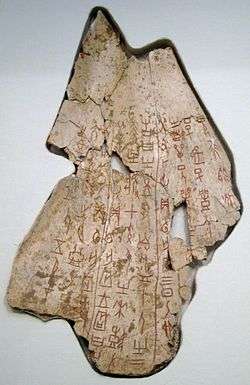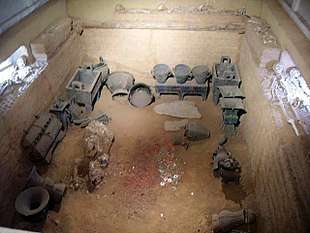Yinxu
 The ruins of Yin, the capital (1350–1046 BC) of the Shang (Yin) dynasty | |
 Shown within Henan  Yinxu (China) | |
| Location | Yindu District, Anyang, Henan, China |
|---|---|
| Coordinates | 36°08′22″N 114°18′11″E / 36.13944°N 114.30306°ECoordinates: 36°08′22″N 114°18′11″E / 36.13944°N 114.30306°E |
| UNESCO World Heritage site | |
| Criteria | Cultural: ii, iii, iv, vi |
| Reference | 1114 |
| Inscription | 2006 (30th Session) |
| Area | 414 ha |
| Buffer zone | 720 ha |
| Yinxu | |||||||||||||||||||||
.svg.png) "Yinxu" in Chinese characters | |||||||||||||||||||||
| Chinese | 殷墟 | ||||||||||||||||||||
|---|---|---|---|---|---|---|---|---|---|---|---|---|---|---|---|---|---|---|---|---|---|
| Literal meaning | "Ruins of Yin" | ||||||||||||||||||||
| |||||||||||||||||||||
Yinxu (modern IPA: [ín.ɕý]; Chinese: 殷墟; literally: "Ruins of Yin") is the site of one of the ancient and major historical capitals of China. It is the source of the archeological discovery of oracle bones and oracle bone script, which resulted in the identification of the earliest known Chinese writing. The archeological remnants (or ruins) known as Yinxu represent the ancient city of Yin, the last capital of China's Shang dynasty which existed through eight generations for 255 years, and through the reign of 12 kings. Yinxu was discovered, or rediscovered, in 1899. It is now one of China's oldest and largest archeological sites, and has been selected as a UNESCO World Heritage Site. Yinxu is located in northernmost Henan province near the modern city of Anyang, and near the Hebei and Shanxi province borders. Public access to the site is permitted.
Traditional history
According to the 2nd century Shuowen Jiezi dictionary, the Chinese character "殷" (yīn) originally referred to "vibrant music-making".[1] Although frequently used throughout written history to refer to both the Shang dynasty and its final capital, the name Yīn (殷) appears to have not been used in this way until the succeeding Zhou dynasty. In particular, the name does not appear in the oracle bones, which refer to the state as Shāng (商), and its final capital as Dàyì Shāng (大邑商 "Great Settlement Shang").[2]
Among surviving ancient Chinese historical documents, Yin is described as the final capital of the Shang dynasty. There is some disagreement, though, as to when the move to Yin took place. Both the Book of Documents, (specifically, the "Pan Geng" chapter, which is believed to date from the late Spring and Autumn period), and the Bamboo Annals state that Shang king Pan Geng moved the Shang capital to Yin. The Bamboo Annals state, more specifically, that during his reign Pan Geng moved the capital from Yān (奄; present-day Qufu, in present-day Shandong Province), to a site called Běimĕng (北蒙), where it was then renamed to Yīn (殷).[3][4][5] (Conversely, according to the Records of the Grand Historian of Sima Qian, Pan Geng moved the Shang capital from a location north of the Yellow River to Bo 亳, the capital of Shang dynasty founder Tang, on the south side of the river—a location inconsistent with the location of Yin.[6])
Regardless, Yin was clearly established as the Shang capital by the time of Shang king Wu Ding. Wu Ding launched numerous military campaigns from this base against surrounding tribes, thus securing Shang rule and raising the dynasty to its historical zenith.
According to the traditional accounts, later rulers became pleasure-seekers who took no interest in state affairs. King Zhòu, the last of the Shang dynasty kings, is particularly remembered for his ruthlessness and debauchery. His increasingly autocratic laws alienated the nobility until King Wu of the Zhou dynasty was able to gain the support to rise up and overthrow the Shang.
The Zhou dynasty established their capital at Fenghao near modern-day Xi'an, and Yīn was abandoned to fall into ruin. These ruins were mentioned by Sima Qian in his Records of the Grand Historian, and described in some detail by Li Daoyuan in his Commentary to the River Classic, published during the Southern and Northern Dynasties period (420-589 CE). Thereafter, the once-great city of Yīn was relegated to legend along with its founding dynasty until its rediscovery in the final years of the Qing dynasty.
Archaeological discoveries

Yinxu is well known for its oracle bones, which were first recognized as containing ancient Chinese writing in 1899 by Wang Yirong, director of the Imperial College.[7] One account of Wang's discovery was that he was suffering from malaria at the time and was prescribed Longgu 龍骨 (dragon bones) at a traditional Chinese pharmacy. He noticed strange carvings on these bones and concluded that these could be samples of an ancient form of Chinese writing.
News of the discovery of the oracle bones created a market for them among antiques collectors, and led to multiple waves of illegal digs over several decades, with tens of thousands of pieces taken.[8][9] The source of the "dragon bones" was eventually traced to the small village of Xiaotun, just outside Anyang.[7] In 1910, noted scholar Luo Zhenyu affirmed that the area was the site of the last Shang dynasty capital.[10] In 1917, Wang Guowei deciphered the oracle bone inscriptions of the names of the Shang kings and constructed a complete Shang genealogy. This closely matched that in the Records of the Grand Historian by Sima Qian, confirming the historical authenticity of the legendary Shang dynasty and the archaeological importance of Yinxu.[7] However, the oracle bone inscriptions record the name of the state as Dàyìshāng (大邑商) or Shāngyì (商邑).
The first official archeological excavations at Yinxu were led by the archeologist Li Ji of the Institute of History and Philosophy from 1928-37.[11] They uncovered the remains of a royal palace, several royal tombs, and more than 100,000 oracle bones that show the Shang had a well-structured script with a complete system of written signs.[12]
Since 1950 ongoing excavations by the Institute of Archaeology, Chinese Academy of Social Sciences have uncovered evidence of stratification at the Hougang site, remains of palaces and temples, royal cemeteries, oracle bone inscriptions, bronze and bone workshops and the discovery of the Huanbei site on the north bank of the Huan River.[11] One of the largest and oldest sites of Chinese archaeology, excavations here have laid the foundation for work across the country.
Four periods are recognized at the site. They correlate approximately with oracle bone periods assigned by Dong Zuobin, royal reigns and dates assigned by the Xia–Shang–Zhou Chronology Project as follows:[13][14]
| Layer | Oracle bone period | Kings | Approximate dates |
|---|---|---|---|
| Yinxu I | Pan Geng, Xiao Xin, Xiao Yi | 1300–1250 BCE | |
| Yinxu II | I | Wu Ding | 1250–1192 BCE |
| II | Zu Geng, Zu Jia | 1191–1148 BCE | |
| Yinxu III | III | Lin Xin, Geng Ding | |
| IV | Wu Yi, Wen Wu Ding | 1147–1102 BCE | |
| Yinxu IV | V | Di Yi, Di Xin | 1101–1046 BCE |
Excavation sites
At 30 km² this is the largest archaeological site in China and excavations have uncovered over 80 rammed-earth foundation sites including palaces, shrines, tombs and workshops. From these remains archaeologists have been able to confirm that this was the spiritual and cultural center of the Shang dynasty.[15]

The best preserved of the Shang dynasty royal tombs unearthed at Yinxu is the Tomb of Fu Hao. The extraordinary Lady Hao was a military leader and the wife of Shang King Wu Ding. The tomb was discovered in 1976 by Zheng Zhenxiang and has been dated to 1250 BCE. It was completely undisturbed, having escaped the looting that had damaged the other tombs on the site, and in addition to the remains of the Queen the tomb was discovered to contain 6 dog skeletons, 16 human slave skeletons, and numerous grave goods of huge archaeological value. The tomb was thoroughly excavated and extensively restored and is now open to the public.
Also located on site is the Exhibition Hall of Chariot Pits where the earliest samples of animal-driven carts discovered by Chinese archaeology are on display.[16] These artifacts were excavated by the Anyang Working Station of the Archaeological Institute of the Chinese Social Science Academy and the Historical Relics Working Team of Anyang Municipality in the northern and southern lands of Liujiazhuang village and the eastern land of Xiaomintun village and put on display within the hall.[17] The six pits each contain the remains of a carriage and two horses. Five of the pits were also found to contain the remains of a human sacrifice (four adult males and one child). Also on display are the remains of an 8.35 meter wide Shang dynasty road discovered at Anyang Aero Sports School in 2000.[18]
In 2006 the site was inscribed on the UNESCO list of World Heritage Sites.[19]
Genetic studies
A study of mitochondrial DNA (inherited in the maternal line) from Yinxu graves showed similarity with modern northern Han Chinese, but significant differences from southern Han Chinese.[20]
See also
References
Citations
- ↑ See Shuowen Jiezi 說文解字 entry 殷.
- ↑ Keightley (1999), p. 232.
- ↑ "Pan Geng I". Chinese Text Project. Retrieved 29 March 2018.
- ↑ "Pan Geng". Chinese Text Project. Retrieved 28 March 2018.
- ↑ Bai, Shouyi (2002). An Outline History of China. Beijing: Foreign Language Press. ISBN 7-119-02347-0.
- ↑ "Annals of Yin". Chinese Text Project. Retrieved 28 March 2018.
- 1 2 3 "The Discovery of Oracle Bones and the Locating of Yinxu site". The Garden Museum of Yin Ruins.
The Discovery of Oracle Bones and the Locating of Yinxu site. In 1899, Wang Yirong, the director of the Imperial College and a well-known scholar of ancient inscriptions discovered dragon bones (known today as oracle bone inscriptions). He sent his assistants to Xiaotun village in Anyang, 安陽, and enabled him to confirm that Xiaotun was indeed the Yinxu (Ruins of Yin) in the historical records. In 1917 Wang Guowei successfully deciphered the names in oracle bone inscriptions of Shang ancestors and from these was able to reconstruct the Shang genealogy. It matched the record in 司馬遷, Sima Qian’s ‘Shiji’, 史記 (Records of the Historian). Thus, the legend of Shang dynasty was confirmed as history and the importance of Yinxu was recognized by the academic world. The first excavations at Yinxu began in 1928.
- ↑ Chou 1976, p. 1.
- ↑ Xu 2002, p. 6.
- ↑ Wilkinson (2000), p. 391.
- 1 2 "Information Panel". The Garden Museum of Yin Ruins.
Since the first excavation in 1928, archaeologists have been working at the Yinxu site for over seventy years. There have been two main periods of excavation: (1) from 1928–1937, when excavations were carried out by the Institute of History and Philosophy; and (2) since 1950, when the Institute of Archeology, Chinese Academy of Social Sciences (formerly Chinese Academy of Sciences) have been responsible for excavations have yielded some very important results: evidence of stratification of the Hougang site, remains of palaces and temples, royal cemeteries, oracle bone inscriptions, bronze-and bone-workshops and the discovery of the Shang city on the north bank of the Huan River.
- ↑ "An Yang, ancient capital of the Shang dynasty". China Central Television. Retrieved August 6, 2007.
- ↑ Thorp, Robert L. (1981). "The Date of Tomb 5 at Yinxu, Anyang: A Review Article". Artibus Asiae. 43 (3): 239–246. JSTOR 3249839. p. 241.
- ↑ XSZCP Group (2000), Xià-Shāng-Zhōu duàndài gōngchéng 1996—2000 nián jiēduàn chéngguǒ bàogào: Jiǎn běn 夏商周断代工程1996—2000年阶段成果报告: 简本 [The Xia-Shang-Zhou Chronology Project Report for the years 1996–2000 (abridged)], Beijing: 世界图书出版公司, ISBN 978-7-5062-4138-0
- ↑ "Foundation Sites of Palaces and Ancestral Shrines of Yinxu". The Garden Museum of Yin Ruins.
Yinxu is the historical remains of the capital city of the Period of the Shang dynasty. In 1300 B.C., King Pan Gang removed his capital to the area around Xiaotun Village in the northwest of the present Anyang City, which was call Yin in the history. The capital lasted 255 years for 12 kings in 8 generations. Being the main component of Yinxu, the Palace and Ancestral Shrine Foundation Sites of Yinxu covered a total area of about 700 thousand square meters. The archaeological excavation was started from 30s of the last century and discovered over 80 rammed-earth foundation sites, among which there were not only palaces, ancestral shrines, sacrificial altar, defensive trench, but also workshops, oracle bone pits, sacrificial pits, noblemen’s tombs and so on, and a large number of oracle bone inscriptions, bronze vessels, jade objects and other precious historical relics have been unearthed. Being the initiating place of the Chinese archaeology, Yinxu was in the first group of the important units of historical relics under the protection of the state. The three key elements of the capital city, the written language and bronzes possessed by the culture of Yinxu have been the witness of the Chinese long history and splendid civilization.
- ↑ "Exhibition Hall of Chariot Pits". The Garden Museum of Yin Ruins.
The chariots of the Shang dynasty excavated in Yinxu have been the earliest sample of animal-driven carts discovered by Chinese archaeology. These 6 chariot pits of the Shang dynasty and the remains of road of the Shang dynasty were excavated separately by Anyang Working Station of the Institute of Archaeology of the Chinese Academy of Social Sciences and the Historical Relics Working Team of Anyang Municipality in the protective area of Yinxin in recent years. The chariot pits were preserved well basically, one chariot one pit, there are two horses in each of the 5 pits and there is one person buried in each of the 4 pits. Through the appraisement, most of the immolated were adult men and one was a boy. The chariot pit of the Shang dynasty have not only exhibited the level of civilization of the ancient animal-drawn carts, but also reflected the cruel institution of immolation in the slave society.
- ↑ "The Exhibition Hall of Chariot pits of the Yin dynasty". The Garden Museum of Yin Ruins.
The 6 pits of the Yin dynasty and the restored remains of a road of the Yin dynasty exhibited here were excavated separately by Anyang Working Station of the Archaeological Institute of the Chinese Social Science Academy and the Historical Relics Working Team of Anyang Municipality in the northern and southern lands of Liujiazhuang Village and the eastern land of Xiaomintun Village in the protective area of the Yin Ruins, and the remains of the road of the Shang dynasty was excavated in the southern land of Anyang Aero Sports School. These chariot pits were preserved well basically and are of high value of academic research and exhibition. There is one chariot in each pit, there are two horses in each of the 5 pits and there is one person buried in each of the 4 pits. Through the appraisement, most of the immolated were a full man and one was a boy. The chariot pits of the Yin dynasty have not only exhibited the level of civilization of the ancient-animal-drawn cars, but also reflected the cruel institution of immolation in slave society.
- ↑ "The Remains of a Road of the Shang Dynasty (with racks to the two directions)". The Garden Museum of Yin Ruins.
The road was about 8.35 meters wide. This was discovered in Anyang Aero Sports School in 2000.
- ↑ "Yin Xu". UNESCO. Retrieved August 6, 2007.
The archaeological site of Yin Xu, close to Anyang City, some 500 km south of Beijing, is an ancient capital city of the late Shang dynasty (1300 to 1046 BC). It testifies to the golden age of early Chinese culture, crafts and sciences, a time of great prosperity of the Chinese Bronze Age. A number of royal tombs and palaces, prototypes of later Chinese architecture, have been unearthed on the site. The site includes the Palace and Royal Ancestral Shrines Area (1,000m x 650m), with more than 80 house foundations, and the only tomb of a member of the royal family of the Shang dynasty to have remained intact, the Tomb of Fu Hao. The large number and superb craftsmanship of the burial accessories found there bear testimony to the advanced level of Shang handicraft industry, and form now one of the national treasures of China. Numerous pits containing bovine shoulder blades and turtle plastrons have been found in Yin Xu. Inscriptions on these oracle bones bear invaluable testimony to the development of one of the world’s oldest writing systems, ancient beliefs and social systems.
- ↑ Zeng, Wen; Li, Jiawei; Yue, Hongbin; Zhou, Hui; Zhu, Hong (2013). "Poster: Preliminary Research on Hereditary Features of Yinxu Population".
Works cited
- Lin, Ershen (July 19, 2007). "A Critical Review on the Rise of Civilization, the Formation of the State, and Early Slavery". draft. The Science & Philosophy Forums (2005–2008). Retrieved 2009-03-03.
- Schinz, Alfred (1996). The magic square: cities in ancient China. Edition Axel Menges. p. 428. ISBN 3-930698-02-1.
- Keightley, David N. (1999), "The Shang: China's first historical dynasty", in Loewe, Michael; Shaughnessy, Edward L., The Cambridge History of Ancient China, Cambridge: Cambridge University Press, pp. 232–291, ISBN 978-0-521-47030-8.
- Chou, Hung-hsiang 周鴻翔 (1976). Oracle Bone Collections in the United States. University of California Press. ISBN 0-520-09534-0.
- Xu, Yahui (許雅惠 Hsu Ya-huei) (2002). Ancient Chinese Writing, Oracle Bone Inscriptions from the Ruins of Yin. English translation by Mark Caltonhill and Jeff Moser. Taibei: National Palace Museum. ISBN 978-957-562-420-0.
- Wilkinson, Endymion (2000). Chinese History: A Manual (2nd ed.). Harvard University Asia Center. ISBN 978-0-674-00249-4.
External links
| Preceded by Yan |
Capital of China Shang 1350 BC – 1046 BC |
Succeeded by Hao |
